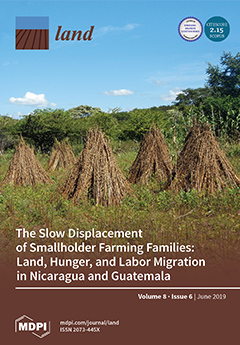The denitrification rate in C
2H
2-amended intact soil cores and soil N
2O fluxes in closed static chambers were monitored in a Mediterranean irrigated maize-cropped field. The measurements were carried out during: (i) a standard fertilization management (SFM) activity
[...] Read more.
The denitrification rate in C
2H
2-amended intact soil cores and soil N
2O fluxes in closed static chambers were monitored in a Mediterranean irrigated maize-cropped field. The measurements were carried out during: (i) a standard fertilization management (SFM) activity and (ii) a manipulation experimental (ME) test on the effects of increased and reduced application rates of urea at the late fertilization. In the course of the SFM, the irrigations following early and late nitrogen fertilization led to pulses of denitrification rates (up to 1300 μg N
2O-N m
−2 h
−1) and N
2O fluxes (up to 320 μg N
2O-N m
−2 h
−1), thanks to the combined action of high soil temperatures and not limiting nitrates and water filled pore space (WFPS). During the ME, high soil nitrates were noted in all the treatments in the first one month after the late fertilization, which promoted marked N-losses by microbial denitrification (from 500 to 1800 μg N
2O-N m
−2 h
−1) every time the soil WFPS was not limiting. At similar maize yield responses to fertilizer treatments, this result suggested no competition for N between plant roots and soil microbial community and indicated a probable surplus of nitrogen fertilizer input at the investigated farm. Correlation and regression analyses (CRA) on the whole set of data showed significant relations between both the denitrification rates and the N
2O fluxes with three soil physical-chemical parameters: nitrate concentration, WFPS and temperature. Specifically, the response functions of denitrification rate to soil nitrates, WFPS and temperature could be satisfactorily modelled according to simple Michaelis-Menten kinetic, exponential and linear functions, respectively. Furthermore, the CRA demonstrated a significant exponential relationship between N
2O fluxes and denitrification and simple empirical functions to predict N
2O emissions from the denitrification rate appeared more fitting (higher concordance correlation coefficient) than the predictive empirical algorithm based on soil nitrates, WFPS and temperature. In this regard, the empirically established relationships between the denitrification rate on intact soil cores under field conditions and the soil variables provided local-specific threshold values and coefficients which may effectively work to calibrate and adapt existing N
2O process-based simulation models to the local pedo-climatic conditions.
Full article





